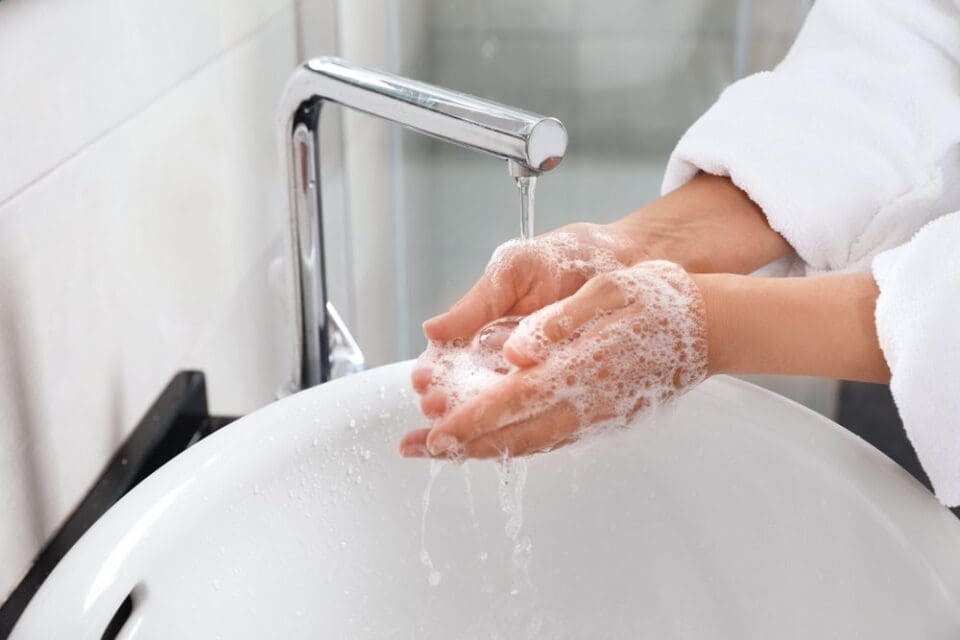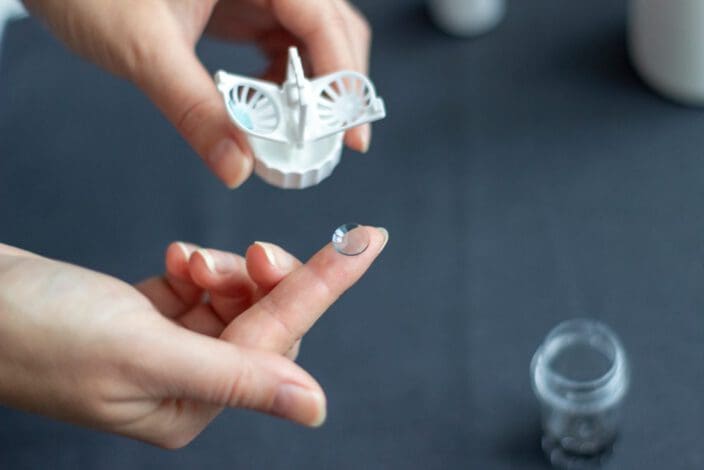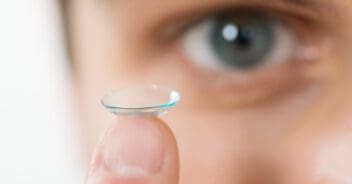How to Safely (& Easily) Put in Contact Lenses
Home / Understanding Contacts /
Last Updated:
Safely and easily putting contacts in begins by thoroughly washing your hands. This will ensure that when you move the lenses from their case to your eyes, your fingers will be as clean as possible.
Table of Contents
Mistakes when putting contacts in include putting on makeup before the lenses or using saliva to lubricate them. With some simple habits and following the directions, you can keep your contacts clean and in good condition for a long time.
Start by Washing Your Hands
If you are new to wearing contact lenses, the American Academy of Ophthalmology has some tips on how you can safely (and easily) put in your new corrective lenses.
To start with, wash your hands before touching your eyes or your lenses. Good handwashing consists of running your hands under hot water for 15 seconds, making sure to scrub your fingertips, under your fingernails, the webbing between your fingers, and the backs of your hands.
You deserve clear vision. We can help.
With 135+ locations and over 2.5 million procedures performed, our board-certified eye surgeons deliver results you can trust.
Your journey to better vision starts here.

If running water is not available, you can use an alcohol-based sanitizer that contains at least 60 percent alcohol.
Whether you use water or hand sanitizer, make sure your hands are completely dry before moving to your contacts. Use a clean towel to dry them.
From the Case to Your Fingertips
Give the lens storage container a light shake to loosen the lenses if they have gotten stuck to the container. Gently slide the lens into your hand. You can use your fingertips, but not your fingernails.
Use your contact lens solution to completely rinse the lens. Do not, under any circumstances, use tap water. The Environmental Protection Agency warns that tap water is not sterile, and if it comes into contact with your eyes, it could lead to an infection.
Lightly place the contact lens on the tip of the index finger of your dominant hand. Check the lens for torn or damaged areas, and ensure than the lens is the right side up. If the edges turn up, like a bowl, then the lens is ready to be put in position. If the edges turn down, the lens needs to be reversed.

Putting Contacts In
Stand in front of a mirror, and use your other hand (the nondominant one) to hold your upper eyelid open. With your dominant hand, use whichever finger is not holding the contact lens to hold down your lower eyelid. You can also use the thumb and fingers of your nondominant hand to keep your upper and lower eyelids wide open.
Place the lens on your eye. Some people like to look up toward the ceiling as they do this. Others prefer to look straight ahead.
Slowly close your eyes, and roll them in a full circle. This will help the lens to settle in properly. You can gently massage your closed eyelids. When you feel like the lens is in position, open your eyes and slowly blink a few times. Use a mirror to check that the lens is on the center of your eye.
You will know you have done this correctly if the lens feels comfortable, and you can see clearly.
Tips for Safety & Ease
If you are new to contact lenses, here are some tips to help you with easily and safely putting contacts in.
A good rule of thumb is to keep your fingernails short, to ensure that you don’t scratch your eyeball.
Make it a habit to put the first contact lens in the same eye, whether it is the left eye or the right eye. This will reduce the chances of accidentally putting the wrong lens in the wrong eye, especially if you are in a hurry or otherwise distracted when putting in your contacts.
Common Mistakes
Make it a point to use rewetting drops as recommended, so your eyes always stay moist and healthy. Take regular breaks from looking at a screen. Blink often, and do eye exercises. They will not improve your vision, but they will reduce eyestrain.
It is also important to remember that when you are ready to take your contacts off, you should always start the process by washing your hands with the same method and thoroughness as you do when you put them on.

Many people make mistakes when they put in their contact lenses, whether they are new to the process or they’ve been doing it for decades. Some of them are basic hygiene precautions.
Reader’s Digest reminds everyone to “always wash your hands with soap and water before touching your eyes.” There will always be germs, but washing ensures that the amount of bacteria coming into contact with your eyes will be minimal.
After washing hands, many people don’t dry their fingers well enough before touching their contacts and their eyes. Reader’s Digest advises contact lens wearers that their fingers should be “as dry as possible before putting your lens in” and to use a clean towel every time. Contacts adhere to the surface of the eye primarily due to the moisture in the eye. Optimally, contacts are “supposed to go from the dry finger to the wet eye,” and the drier a hand is, the easier a contact lens is to handle.
Teen Vogue points out another common mistake that some people make when putting contacts in: They apply their makeup first. Instead, “makeup goes last.”
Doctors interviewed for the Teen Vogue piece said that lenses should not catch any makeup or chemical products on the way to the eye. If the contact is in place, makeup and accessories can be applied with the usual precautions. But to keep the lenses as clean as possible, don’t try to put them in when your makeup is already on.
You deserve clear vision. We can help.
With 135+ locations and over 2.5 million procedures performed, our board-certified eye surgeons deliver results you can trust.
Your journey to better vision starts here.
What if I Am Unable to Put in Contacts?
Some people struggle with using contact lenses. The challenge most users face is fear, which comes from myths, lack of practice, fear of germs, and inability to control their blinking.
First, learn to separate fact from myths and avoid falling for false risks and discomfort narratives to overcome these. Only use information from trusted sources and your doctor.
You should also practice with a dry run and learn to control your blinking to make the putting-in process easier and comfortable.
How to Take Care of Your Contacts
In reviewing the proper way to take care of contact lenses, the American Academy of Ophthalmology encourages people to fully clean and disinfect contact lenses after they are removed from the eye and before the lenses are put back in. How exactly to perform this cleaning, and what materials are required, depends on the type of lens you have been prescribed, if you have any allergies, or if your eyes has conditions where they develop protein deposits. An optometrist will be able to point you in the right direction for what kind of cleaning solutions would work for you.
How you store your contact lenses is also vital to ensure that you protect your eyes from dangerous infections. To keep your lenses clean when they’re not in use, start by following the schedule given to you by your doctor for wearing, storing, and replacing your lenses.
For example, most contact lenses cannot be worn overnight, but some can be. You need to know the difference, and how to properly store your contacts when you go to bed.
Can My Contacts Get Wet?

Don’t wear your contact lenses in the shower, in a hot tub, in a swimming pool, or while performing any activity where water would get in your eyes. Rain should not be a problem, as long as you keep blinking regularly to prevent the rainwater from pooling on your contacts.
Do not use saliva to moisturize your contact lenses. Do not use tap water to moisturize your contact lenses. Do not use a homemade saline solution to wet your contact lenses.
Saline solution or rewetting drops are not disinfectants, so they should not be used to clean your lenses.
Rub & Rinse
Regardless of the type of cleaning solution you buy for your lens, you should use a “rub and rinse” cleaning system, where you rub your contact lenses with your clean fingers, rinse the lenses with solution, and then soak them. In fact, Self writes that not rubbing and rinsing is one of the most common mistakes people make when it comes to their contacts.
Whenever you clean and disinfect your contact lenses, use new solution. Don’t pour contact lens solution into a new bottle, as the solution will lose its sterility and can be prone to passing on infections.
The tip of the solution bottle should not touch a surface, and the bottle itself should be tightly closed when not in use.
After you rinse your contact lens case with sterile solution, leave the empty case open to air dry.
Make it a point to keep your contact lens case clean. Replace it every three months, and replace it immediately if it sustains any damage.
Long-Term Care
If you have to store your lenses in their case for some time, consult the instructions or call your doctor to see if you should re-disinfect them before you wear them again. Do not wear your lenses if they have been stored for more than 30 days without re-disinfecting them first.
Over time, contact lenses can warp, and the shape of your cornea can change. Go to your eye doctor regularly to make sure your contact lenses fit properly, and your prescription is up to date.
Lastly, to clean your contact lenses properly, know the type of lens you have. Disposable, extended-wear soft lenses require the least amount of care, while conventional soft lenses need the most attention.
The packing for your lenses and cleaning equipment should have instructions on how to properly care for them. Your optometrist’s office will also provide you with the necessary information.
You deserve clear vision. We can help.
With 135+ locations and over 2.5 million procedures performed, our board-certified eye surgeons deliver results you can trust.
Your journey to better vision starts here.
References
- How to Put In Contact Lenses. (April 2018). American Academy of Ophthalmology.
- Wash Your Hands. (April 2019). Centers for Disease Control and Prevention.
- The Danger of Using Tap Water With Contact Lenses. Environmental Protection Agency.
- The Easiest Way to Put Contact Lenses In. (March 2017). Lifehacker Australia.
- Eye Exercises: How-To, Efficacy, Eye Health, and More. (February 2018). Healthline.
- 18 Contact Lens Mistakes That Could Ruin Your Eyes. Reader’s Digest.
- How to Wear Contact Lenses, Without Making These Common Mistakes. (June 2018). Teen Vogue.
- How to Take Care of Contact Lenses. (May 2019). American Academy of Ophthalmology.
- Why You Really, Really Shouldn’t Sleep in Your Contacts. (December 2018). Health.
- Eye Care Mistakes You Do not Know You Are Making. (July 2015). Shape.
- 3 Mistakes You Are Making With Your Contact Lenses. (November 2007). Self.
- How to Care for Your Contact Lenses and Eyes. (September 2017). WebMD.
This content is for informational purposes only. It may have been reviewed by a licensed physician, but is not intended to serve as a substitute for professional medical advice. Always consult your healthcare provider with any health concerns. For more, read our Privacy Policy and Editorial Policy.
